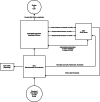User-Centered Design and Implementation of an Interoperable FHIR Application for Pediatric Pneumonia Prognostication in a Randomized Trial
- PMID: 38565189
- PMCID: PMC11254472
- DOI: 10.1055/a-2297-9129
User-Centered Design and Implementation of an Interoperable FHIR Application for Pediatric Pneumonia Prognostication in a Randomized Trial
Abstract
Objectives: To support a pragmatic, electronic health record (EHR)-based randomized controlled trial, we applied user-centered design (UCD) principles, evidence-based risk communication strategies, and interoperable software architecture to design, test, and deploy a prognostic tool for children in emergency departments (EDs) with pneumonia.
Methods: Risk for severe in-hospital outcomes was estimated using a validated ordinal logistic regression model to classify pneumonia severity. To render the results usable for ED clinicians, we created an integrated SMART on Fast Healthcare Interoperability Resources (FHIR) web application built for interoperable use in two pediatric EDs using different EHR vendors: Epic and Cerner. We followed a UCD framework, including problem analysis and user research, conceptual design and early prototyping, user interface development, formative evaluation, and postdeployment summative evaluation.
Results: Problem analysis and user research from 39 clinicians and nurses revealed user preferences for risk aversion, accessibility, and timing of risk communication. Early prototyping and iterative design incorporated evidence-based design principles, including numeracy, risk framing, and best-practice visualization techniques. After rigorous unit and end-to-end testing, the application was successfully deployed in both EDs, which facilitated enrollment, randomization, model visualization, data capture, and reporting for trial purposes.
Conclusion: The successful implementation of a custom application for pneumonia prognosis and clinical trial support in two health systems on different EHRs demonstrates the importance of UCD, adherence to modern clinical data standards, and rigorous testing. Key lessons included the need for understanding users' real-world needs, regular knowledge management, application maintenance, and the recognition that FHIR applications require careful configuration for interoperability.
Thieme. All rights reserved.
Conflict of interest statement
None declared.
Figures






References
Publication types
MeSH terms
Grants and funding
LinkOut - more resources
Full Text Sources
Medical

